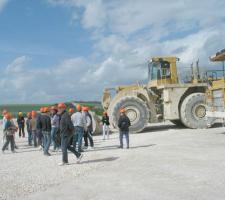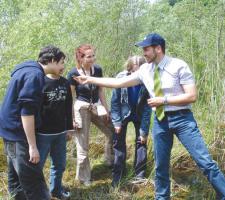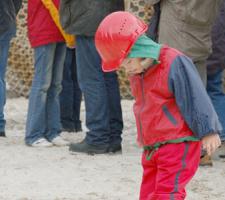
Next year's European Minerals Day promises to be even more successful than the inaugural event in 2007, reports Lisa Russell
Quarries across Europe will join forces next spring to tell people about their work and their role in promoting biodiversity through specially arranged events held across the region at the same time. Guided tours, equipment demonstrations and nature projects will be among the hundreds of activities organised as part of an international initiative, European Minerals Day (EMD), which actually takes place between 15 to 17 May 2009.
The events, which are co-ordinated by the
"Many people do not even realise that there is a quarry nearby, as it is so hidden away and protected," said IMA-Europe secretary general Dr Michelle Wyart-Remy. She believes that members of the public - and indeed people working in the sector - are often unaware of all the efforts undertaken. "We want to show the public how, in a sustainable way, we are taking care of resources and the environment," she said.
"Many companies do already open their doors from time to time," she said. "But we believe that if we focus on a particular weekend then we can attract greater attention."
More than 30,000 visitors were given an introduction to minerals production through the first European Minerals Day, which was held in May 2007 and involved events at 106 sites in 17 countries. Concerts and fireworks joined more serious tours and workshops in helping raise awareness, create a dialogue with neighbours, highlight career opportunities and promote sustainable development.
The first EMD was organised in just six months. With more preparation time available, registrations promise to be higher still for 2009's event - particularly as there are now more associations involved. A key new partner is the
"For us it is very important that we reach as many companies as possible, even the smallest ones," she said. Some aggregates quarries did take part last time, either independently or because some national federations were involved.
"But now we have the cooperation of the European umbrella, which is a better way to spread the message," she added.
There are small quarries everywhere in Europe and they are an essential part of their communities, she said. Local acceptance and good relations with their neighbours are vital. "For me, it is very important that they join in. It's a way of building a better image of the sector," she said. "It's not important whether you produce industrial minerals or aggregates - for people, a quarry is a quarry. It is very important that we join forces in this activity." If an operator has poor relations with the local authorities and public, then it is detrimental to all.
There are two further organisers at European level besides IMA-Europe and UEPG - European Geological Surveys and the European Cement Association (
There is still time for companies to get involved. It is deliberately arranged around a weekend to give flexibility so that school events can take place on the Friday, with the weekend available for more general visits. Most of those who took part last time plan to be involved again, said Wyart-Remy and the hope is that there will be a "snowball" effect as more join in. She found that participants were proud to see the interest shown in their work, to pass on their experiences and explain what was involved.
EMD will be officially launched with a major event at one of the participating quarries.
As part of its undertakings, IMA is already collecting examples of conservation, such as quarries that have created ideal conditions for sand martins to flourish. The commitment to biodiversity also fits in with the European Commission's initiative on raw materials. This covers increasing the supply of raw materials on a sustainable basis, ensuring sustainable and more transparent supply from elsewhere and encouraging greater efficiency in resources.
Although EMD's general theme is biodiversity, participants are free to focus on other topics if that would be more appropriate locally.
"We have a very long list of potential types of events," she said. Suggestions include quarry open days, guided tours, equipment demonstrations, nature projects, geological tours, fossil hunts, presentations on operations and rehabilitation, activities for children and lectures. Not all events take place on the site - there can be classroom activities too. Last year, there was even a rock concert in Finland's Pargas quarry.
IMA-Europe provides a dedicated website - www.mineralsday.eu - that will promote all events. There are also materials to help organise the day, including a logo that can be put onto flags, banners, t-shirts and other branded items. Templates for promotional and careers material come in various languages. For those who wish to be involved, extensive support is available, said Wyart-Remy. Those who are more independent may just use the logo with their own materials. "There are people who are used to organising this kind of event but for others it will be the first time they have opened their doors." Companies may find that they can also tap into local help. For instance, some quarries operated geological tours that were led by a club or museum.
Last year, there was a special focus on children and adolescents, with school events accounting for 40% of the total. Numbers ranged from 30 to 200 pupils, while the public open days typically brought in between 200 and 2,000 visitors.
Although this year's theme is biodiversity, the intention is to continue to reach out to children as well as adults. "We believe it is good to target young people," said Wyart-Remy. "It contributes to their education, they learn easily and they don't have preconceived ideas."
Some of last year's participating companies shared their experiences at a workshop held by IMA-Europe in October. "All the events with schools and those that addressed young people were really successful," said Wyart-Remy. People tend to assume that the key to success is to provide a lot of activities but last year's experience showed that it is just as important to allow time for discussion. "Children ask a lot of questions and want this exchange," said Wyart-Remy. "They want to know more about the people who work there."
It can help attract future recruits to the industry. Sixteen-year-old geology student Charlie Sims commented after last year's event, "It was really interesting to see how the minerals are processed into useable aggregates and I enjoyed learning about the region's history. Today's visit really opened up prospects for my future."

















